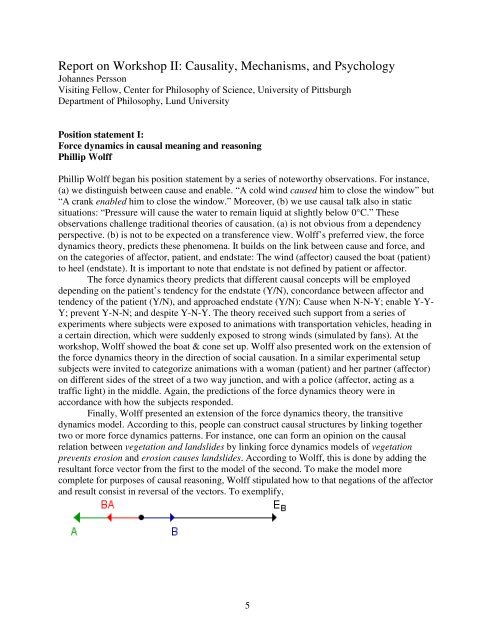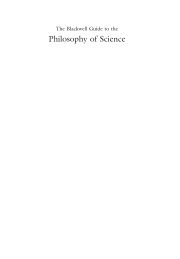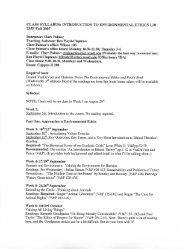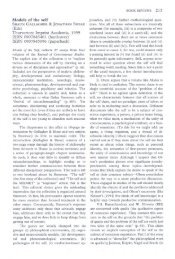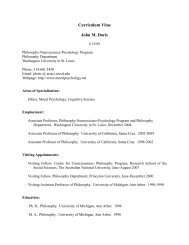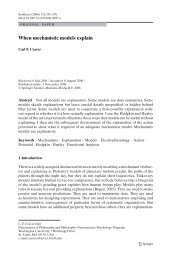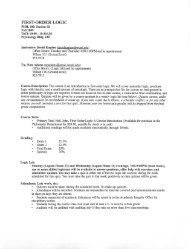Synopsis - The Department of Philosophy - Washington University in ...
Synopsis - The Department of Philosophy - Washington University in ...
Synopsis - The Department of Philosophy - Washington University in ...
Create successful ePaper yourself
Turn your PDF publications into a flip-book with our unique Google optimized e-Paper software.
Report on Workshop II: Causality, Mechanisms, and Psychology<br />
Johannes Persson<br />
Visit<strong>in</strong>g Fellow, Center for <strong>Philosophy</strong> <strong>of</strong> Science, <strong>University</strong> <strong>of</strong> Pittsburgh<br />
<strong>Department</strong> <strong>of</strong> <strong>Philosophy</strong>, Lund <strong>University</strong><br />
Position statement I:<br />
Force dynamics <strong>in</strong> causal mean<strong>in</strong>g and reason<strong>in</strong>g<br />
Phillip Wolff<br />
Phillip Wolff began his position statement by a series <strong>of</strong> noteworthy observations. For <strong>in</strong>stance,<br />
(a) we dist<strong>in</strong>guish between cause and enable. “A cold w<strong>in</strong>d caused him to close the w<strong>in</strong>dow” but<br />
“A crank enabled him to close the w<strong>in</strong>dow.” Moreover, (b) we use causal talk also <strong>in</strong> static<br />
situations: “Pressure will cause the water to rema<strong>in</strong> liquid at slightly below 0°C.” <strong>The</strong>se<br />
observations challenge traditional theories <strong>of</strong> causation. (a) is not obvious from a dependency<br />
perspective. (b) is not to be expected on a transference view. Wolff’s preferred view, the force<br />
dynamics theory, predicts these phenomena. It builds on the l<strong>in</strong>k between cause and force, and<br />
on the categories <strong>of</strong> affector, patient, and endstate: <strong>The</strong> w<strong>in</strong>d (affector) caused the boat (patient)<br />
to heel (endstate). It is important to note that endstate is not def<strong>in</strong>ed by patient or affector.<br />
<strong>The</strong> force dynamics theory predicts that different causal concepts will be employed<br />
depend<strong>in</strong>g on the patient’s tendency for the endstate (Y/N), concordance between affector and<br />
tendency <strong>of</strong> the patient (Y/N), and approached endstate (Y/N): Cause when N-N-Y; enable Y-Y-<br />
Y; prevent Y-N-N; and despite Y-N-Y. <strong>The</strong> theory received such support from a series <strong>of</strong><br />
experiments where subjects were exposed to animations with transportation vehicles, head<strong>in</strong>g <strong>in</strong><br />
a certa<strong>in</strong> direction, which were suddenly exposed to strong w<strong>in</strong>ds (simulated by fans). At the<br />
workshop, Wolff showed the boat & cone set up. Wolff also presented work on the extension <strong>of</strong><br />
the force dynamics theory <strong>in</strong> the direction <strong>of</strong> social causation. In a similar experimental setup<br />
subjects were <strong>in</strong>vited to categorize animations with a woman (patient) and her partner (affector)<br />
on different sides <strong>of</strong> the street <strong>of</strong> a two way junction, and with a police (affector, act<strong>in</strong>g as a<br />
traffic light) <strong>in</strong> the middle. Aga<strong>in</strong>, the predictions <strong>of</strong> the force dynamics theory were <strong>in</strong><br />
accordance with how the subjects responded.<br />
F<strong>in</strong>ally, Wolff presented an extension <strong>of</strong> the force dynamics theory, the transitive<br />
dynamics model. Accord<strong>in</strong>g to this, people can construct causal structures by l<strong>in</strong>k<strong>in</strong>g together<br />
two or more force dynamics patterns. For <strong>in</strong>stance, one can form an op<strong>in</strong>ion on the causal<br />
relation between vegetation and landslides by l<strong>in</strong>k<strong>in</strong>g force dynamics models <strong>of</strong> vegetation<br />
prevents erosion and erosion causes landslides. Accord<strong>in</strong>g to Wolff, this is done by add<strong>in</strong>g the<br />
resultant force vector from the first to the model <strong>of</strong> the second. To make the model more<br />
complete for purposes <strong>of</strong> causal reason<strong>in</strong>g, Wolff stipulated how to that negations <strong>of</strong> the affector<br />
and result consist <strong>in</strong> reversal <strong>of</strong> the vectors. To exemplify,<br />
5


